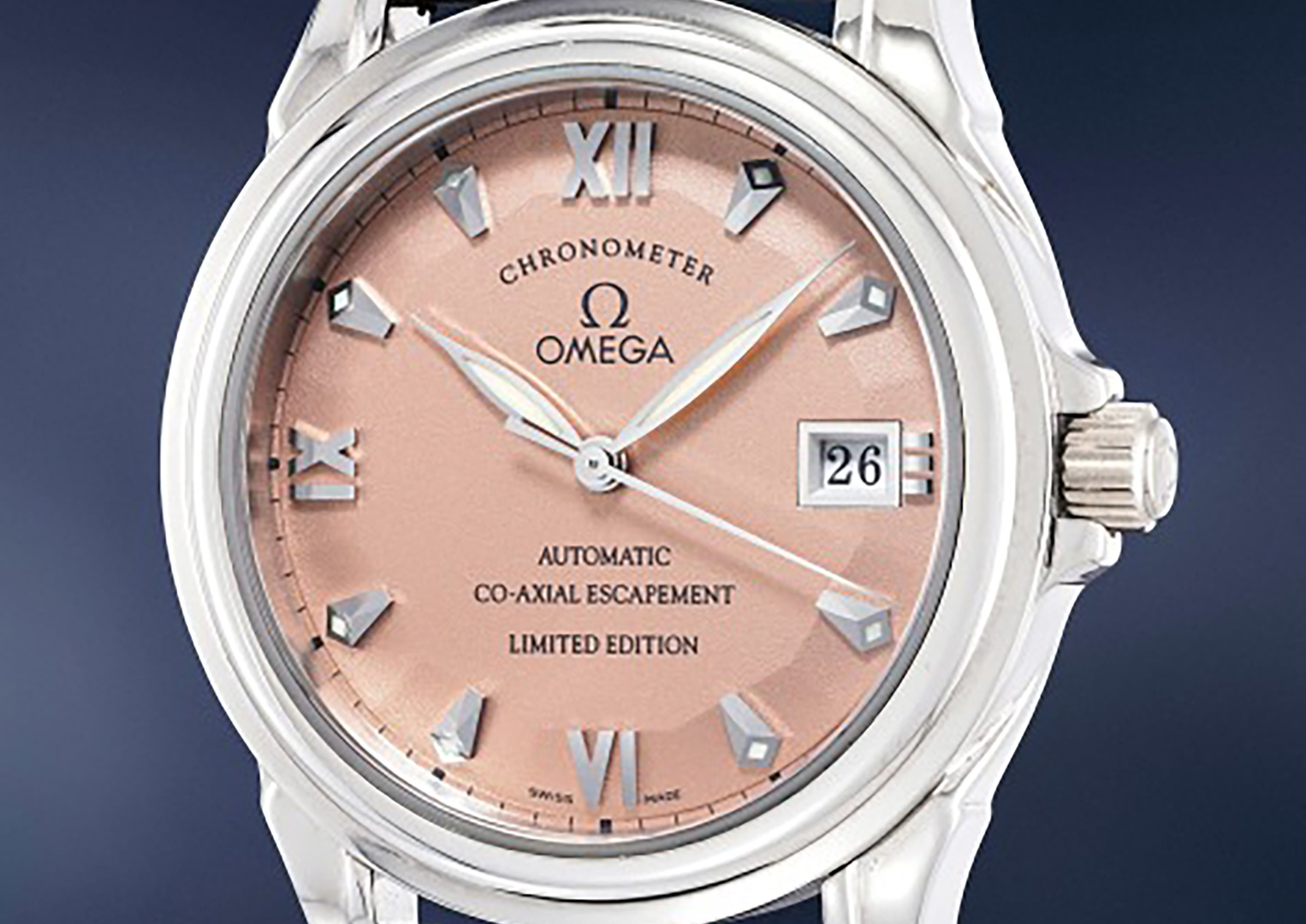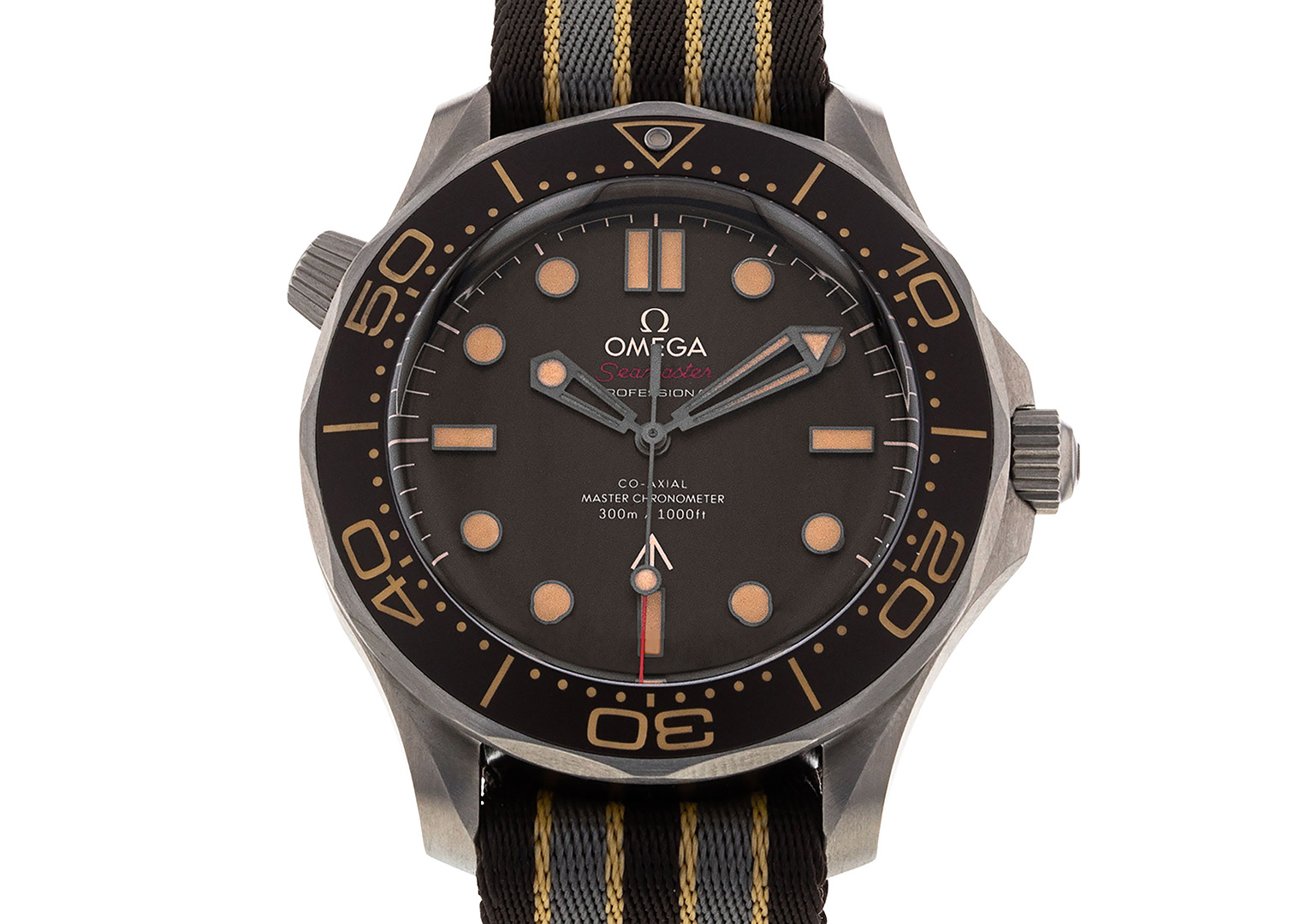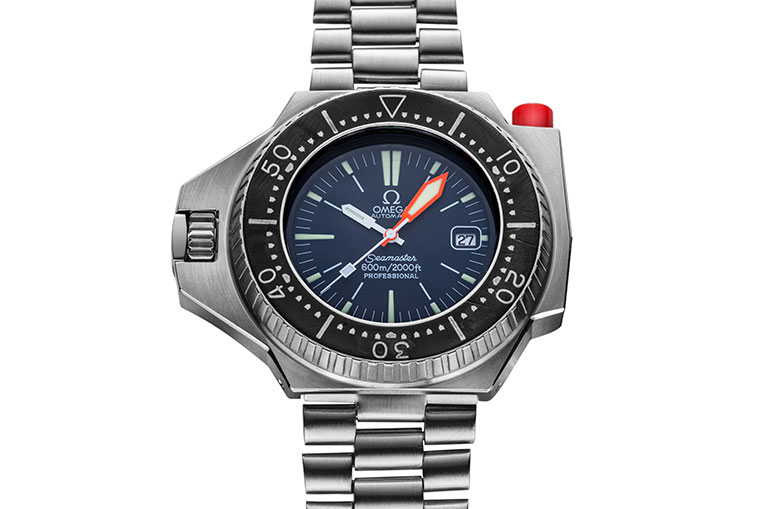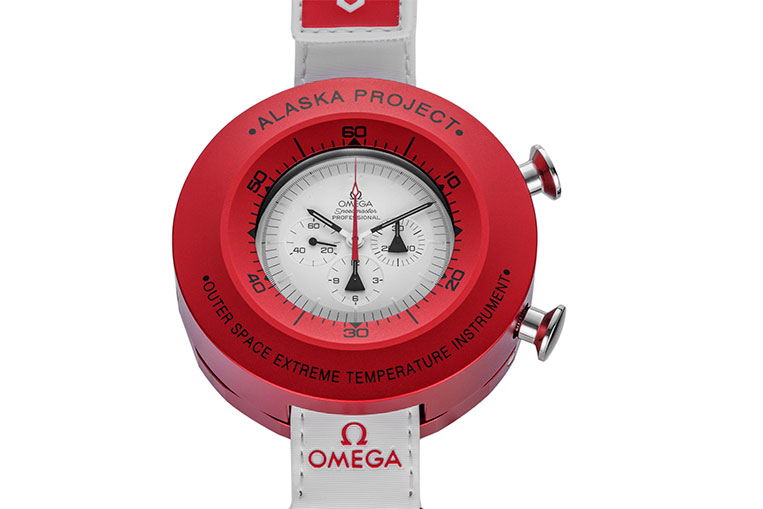Feature: The best 25 Omega watches
One of the most prolific luxury watch brands ever, Omega is characterised by variety, innovation and the courage to travel new paths. Its watches have been to the moon and—fictionally, at least— prevented global destruction as one of James Bond’s life-saving gadgets. Despite an extensive back-catalogue and an outstanding contemporary line-up, we’ve somehow settled on our all-time top 25.
Omega De Ville Rattrapante Platinum Ice, Reference 4642.72.31

Such is Omega’s prolific output that we could easily have come up with a list of 25 models from the De Ville collection alone. If we did, this split-seconds chronograph from 2005 would be jostling for the top spot. Cased in platinum and with a diamond-set bezel and mother-of-pearl dial, this remarkable watch is a potent reminder of Omega’s haute horlogerie capabilities.
Buzz Aldrin’s personal Speedmaster, Reference ST 145.012

Image courtesy of Bonhams
Unless you’ve been living in a cave for decades you’ll know that the most famous watch in the history of horology is astronaut Buzz Aldrin’s Speedmaster, the first watch on the moon. Alas, shortly after Aldrin’s return from the 1969 Appollo 11 mission it went missing on its way to the Smithsonian Museum where it was to be displayed. The watch was thought to be a reference ST 145.012, like the one pictured, or possibly an ST 105.012.
The new-era Omega Bond watch, Reference 2541.80.00

In what might be the smartest marketing coup the watch industry has ever seen, Omega elbowed its way into the James Bond franchise in the 1990s, ending the decades-long unofficial relationship between Bond and his trusty Rolex Submariner. This no-frills Seamaster 300m might run on a quartz battery but it ushered in a new era when actor Pierce Brosnan wore it in his Bond debut, GoldenEye. Sadly, the real version didn’t come with a laser-cutter.
The discontinued Dynamic, Reference 5240.50.00

Launched at the end of the 1960s, the first Dynamic watches featured UFO-style oval cases and concentric dials that were very much of their era. This is a third-generation model that was introduced in the late 1990s and strangely discontinued after a short production run. Omega made time-only and chronograph versions, like this one, but both came with chunky lozenge hands and a quirky font that gave it a more casual aesthetic than most of the brand’s watches.
Petrograd, Museum collection, Reference 5703.30.01

The watch industry owes much to the Art Deco period. It brought us, among other things, Jaeger-LeCoultre’s Reverso, one of the most distinctive timepieces ever made. Omega’s Petrograd was originally made in 1915 for the Russian market—hence the name—and is another quintessentially Art Deco piece thanks to its tonneau case and decorative radial numerals. Omega re-released it in 2003 as part of its limited-edition Museum collection.
Speedmaster Moonwatch Professional in Canopus Gold, Reference 310.60.42.50.02.001

Take the most iconic watch of all time, make it in white (or “Canopus”) gold instead of the usual tool-watch steel, and put its beautifully refined movement on full display through an exhibition caseback. The result is a Moonwatch to eclipse all Moonwatches. At a little over $60k, you would have to be some kind of NASA-obsessed astronomer with pockets as deep as craters to buy this, but it’s worth it.
De Ville tourbillon, Reference 528.53.44.21.03.001

Tourbillons may not be the first things that spring to mind when talking about Omega, but the brand was actually the first to put one in a wristwatch movement back in 1947. This beautiful model in its current De Ville collection places this complex mechanism at the centre of a concentric dial that radiates elegance. The case is Sedna gold, Omega’s own version of rose gold, as is the dial which is coated with blue PVD.
Omega Andrew Grima “Teak” watch

Image courtesy of Bonhams
In the 1960s someone at Omega clearly looked at Rolex’s Midas watch—a highly unconventional-looking chunk of 18k gold—and decided they could do better. For this, they recruited British jeweller Andrew Grima. His designs for Omega, like this Teak model, were of their time and unlike anything Omega had made before. For Grima, dial legibility was of little importance. “If you need to know the time you ask your chauffeur,” he reportedly said.
Soccer watch, Reference 145.016

Image courtesy of Phillips
So-called “soccer” watches—chronographs that timed the 45-minute halves of football matches—had their heyday between the late 1960s to the 1980s, back when players weren’t all primadonnas with expensive haircuts. You can find examples by Breitling, Seiko and Omega, among others, but the dial on this model is particularly vibrant. Despite its name, this watch shared the same chronograph calibre found in some Speedmasters of the era.
The first ever Omega with a co-axial escapement, Reference 39905006

Image courtesy of Phillips
The biggest Omega milestone of the past thirty years is its introduction in 1999 of the co-axial escapement, invented by English watchmaker George Daniels. Producing less friction than standard escapements and thus requiring less lubrication, it was considered such a horological leap forward that Omega eventually began using it for all its mechanical watches. This is the very model—now incredibly sought-after—that introduced Daniels’ genius creation to the world.
Omega Ranchero, Reference CK2990

Image courtesy of Phillips
The word “Ranchero” might sound good in English but in Spanish-speaking countries it translates as ranch-hand—a manual labourer who herds cattle. So you can see why this manual-wind watch, launched in 1957, didn’t take the world by storm. Indeed, it was discontinued after only a couple of years, which makes it one of the most collectible—and faked—vintage Omegas around.
Omega Railmaster, Reference 220.10.40.20.06.001

Another classic from Omega’s fruitful 1950s is the Railmaster, made for those working close to electrical fields. Vintage models came with a black-dial and a broad-arrow hour hand, like the Ranchero. The contemporary version takes things to another level with a Master Chronometer movement that can resist magnetic fields of 15,000 gauss—more than a Rolex Milgauss. We like the white-dial iteration, although there’s also a denim-style one to match your jeans.
Omega Seamaster Diver James Bond Edition, Reference 210.92.42.20.01.001

For Daniel Craig’s final Bond film, No Time To Die, Omega gave the character the perfect send-off with this stunning titanium Seamaster Diver 300M. The tropical-brown bezel and dial give it a vintage look which is enhanced by the yellow-brown lume that’s generously applied for better legibility—just what a super-spy needs when fighting villains in the murky ocean depths or a dimly lit casino. Looks great on a striped NATO strap or Milanese mesh bracelet.
Constellation Grand Luxe, Reference OT14355

Image courtesy of Phillips
Constellation models from the 1950s and 1960s can be found in every vintage watch boutique from Tokyo to Turin, but Grand Luxe varieties are rare. These 18k gold chronometers used to be a favourite of mega-rich Middle Eastern royal families, who would order small batches with a ruler’s portrait on the dial. This diamond-dial version in pink gold comes on a sumptuous brick-link bracelet.
The beginner’s chronograph, Reference 146.009

If you want to introduce your eight-year-old child to the wonderful world of chronographs, buy them a Chronostop. Capable of timing nothing longer than a single minute, this simple monopusher model from the late 1960s is about as basic as chronographs get. Still, despite its technical limitations, the barrel-cased Chronostop is a much-loved, affordable vintage classic and readily available on the pre-owned market.
Speedmaster MkII, Reference 145.014

Omega referred to the Speedmaster MkII as the “racing” version due to the dial’s distinctive orange-red checkerboard minutes track. Launched in 1969, it features a barrel-shaped case and the same Caliber 861 movement found in the original Moonwatch. Omega brought it back in 2014, equipping it with a vastly upgraded movement and adding a date window at 6 o’clock but the earlier versions have a little more charm.
Omega Seamaster Aqua Terra Worldtimer, Reference 220.12.43.22.03.001

Omega has made a raft of GMT and worldtimer watches but this visually arresting Aqua Terra model stands out from the current catalogue. With its 24-city display, second time zone and 150-metre water resistance, as well as a tough rubber strap, it’s the kind of holiday watch that will make a statement whether you’re by the pool or at the airport. For those partial to precious metal, there is also a limited-edition platinum version with an enamelled globe.
Speedmaster Anniversary series, Reference 311.63.42.30.03.001

Humans haven’t actually set foot on the moon since 1972 and to commemorate the 45th anniversary of that final landing Omega released this limited-edition Moonwatch “Apollo XVII”. Cased in 18K yellow gold, its dial is blue ceramic with the 9 o’clock subdial bearing a gold image of the God Apollo. Engraved on the caseback are the words “A tribute to Gene Cernan”, the most recent astronaut to walk on the moon.
Speedmaster Broad Arrow Rattrapante, Reference 3582.31.00

This unusual Speedmaster is a great alternative to a panda-dial Rolex Daytona if you can handle its more muscular proportions. This is a perfect marriage of vintage and modern, with the broad-arrow hour hand a throwback to early Speedmasters and the case size a very 21st-century 44mm. That rather large case has to house an automatic split-seconds chronograph movement with a date, but it’s all executed superbly. This discontinued watch is truly underrated.
Omega Constellation Geneva Observatory, Reference 2699SC

Image courtesy of Phillips
This is the ultimate prize for collectors of Omega’s Constellation line. The vibrant cloisonné dial on this 18k yellow-gold watch depicts the cupola of the Geneva Observatory and was part of a small batch made for a Middle Eastern client in 1954. Other models with cloisonné dials depicted everything from mythical characters to maps of Arabia and were made in equally limited batches. Now selling for over $100k, they are among the brand’s biggest hitters at auction.
Speedmaster Snoopy, Reference 310.32.42.50.02.001

Think Snoopy and the Omega Speedmaster is an odd mix? Think again—the collaboration isn’t as random as it looks. After the crucial role Omega’s Speedmaster played during the Apollo 13 mission, NASA awarded Omega with its iconic Silver Snoopy Award—recognising outstanding contributions to the first United States Manned Lunar Landing Project. Since then, Omega has released several Snoopy Speedmasters, which enjoy a cult following among collectors.
Bullhead chronograph, Reference 225.12.43.50.04.001

A contender for the Omega with the most comical name, the Bullhead is one of the watchmaker’s most eye-catching offerings. Originally released in 1969, the Bullhead gets its name from the two horn-like chronograph pushers protruding from the top of its case. Omega recently rereleased the Bullhead via some vintage reissues. The minimalist white dial on this model contrasts with the unconventional case—a nice balance.
Seamaster Ploprof, Reference 166.0077

The Plongeur Professionnel—Professional Diver in English—aka the Ploprof, is a watch developed for performance rather than aesthetics. This beast isn’t for everyone, thanks to its protruding crown and so-called “big red button” that locks and unlocks the bezel. Intended for COMEX divers, the original Ploprof was water-resistant to a depth of 1,370 metres during trials in the 1960s. In 2023, Omega unveiled a new Ploprof to commemorate 75 years of the Seamaster.
Stardust Constellation, Reference ST 396.0806

Sticking to a stellar theme, Omega introduced the aptly named Stardust—a range of mega-quartz watches—to its Constellation collection in the 1970s. This Stardust features a glitzy aventurine dial that’s reminiscent of a starry night’s sky, although plain waffle-dialled versions were also made. This stainless-steel model boasts a frequency of 2.4 megahertz thanks to Omega’s 1510 calibre. This is a rare and collectible Omega watch that was also available in 18k gold.
“Alaska Project” Speedmaster, Reference 311.32.42.30.04.001

Perhaps Omega’s weirdest watch, the “Alaska Project” Speedmaster was introduced in the 1970s and like the original Speedmaster was built for outer space. However the brief for the Alaska model was a lot more thorough—it needed to withstand extremely hot and cold temperatures. So, Omega created a protective suit for it via the epic big red “shell” that encased it. In 2008, Omega reissued the Alaska Project with a limited run of just 1,970 pieces.




